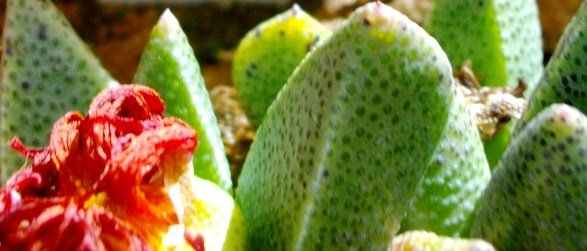Rabiea

Author: Ivan Lätti
Photographer: Ivan Lätti
Rabiea is a genus of dwarf leaf succulents in the Aizoaceae family. The compact, tufted plants grow from fleshy or tuberous rootstocks. The plants branch, growing aloe-like leaf rosettes.
Two or three paired leaves are tightly packed on a stem, the often sickle-shaped leaves of the pair not always identical. The leaf bases are broad, the tips pointed, the leaves very succulent. The inner or upper surfaces are flat, the outer keeled, sometimes indistinctly. Most leaves are about triangular in cross-section, cylindrical ones rare. The leaf surfaces are rough from sometimes conspicuous, white or blackish green spots or raised idioblasts containing tannin.
The flowers grow solitary on short pedicels or nearly sessile with two pairs of bracts below. The cup-shaped flowers open around midday for the afternoon only. There are mostly five nearly equal sepals, sometimes up to seven, fused at the base in a short hypanthium from which the petals and numerous stamens arise. The oblong petals, yellow or yellow orange, grow in three or four whorls. There are nectar glands along the rim of the flower base. The stamens are papillate below. There are seven to ten linear stigmas in a flower, the ovary rounded on top. Flowering happens in spring and summer.
The dark, thick-walled fruit is a capsule with seven to ten locules, rounded on top with valve wings reaching about halfway up. The expanding keels are close together at the base, diverging upwards to near the valve tips. Covering membranes are present but there are no closing bodies. The pear-shaped seeds are dark brown and covered in small protuberances.
There are six Rabiea species in inland parts of the Eastern Cape to the centre of the Free State, and only one species in the east of the Northern Cape. The species are not always easy to tell apart. The plants are adapted to dry, cold winters and summer rain. They are easy to cultivate, requiring good drainage and succeed in containers. Seed, cuttings or division can be used in propagation (Leistner, (Ed.), 2000; Smith, et al, 1998).

